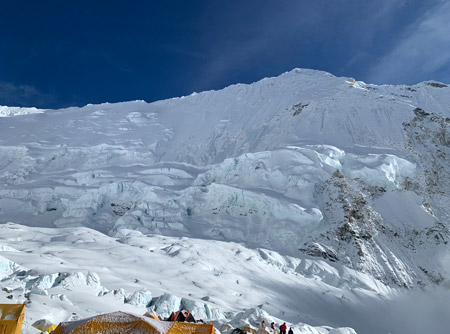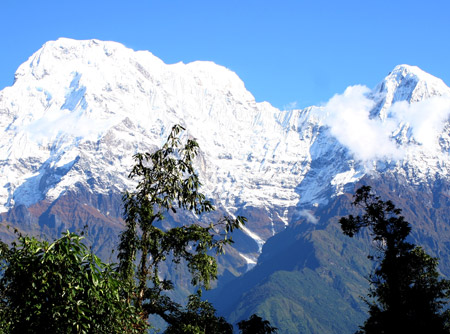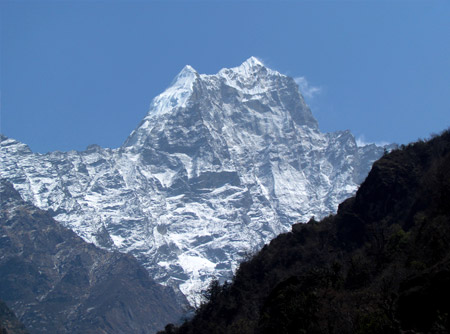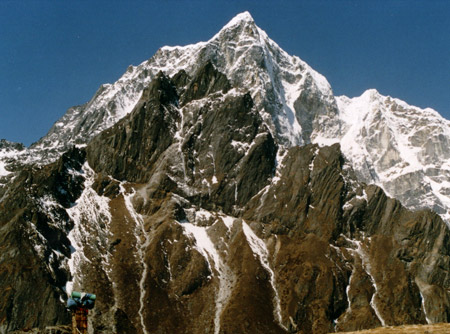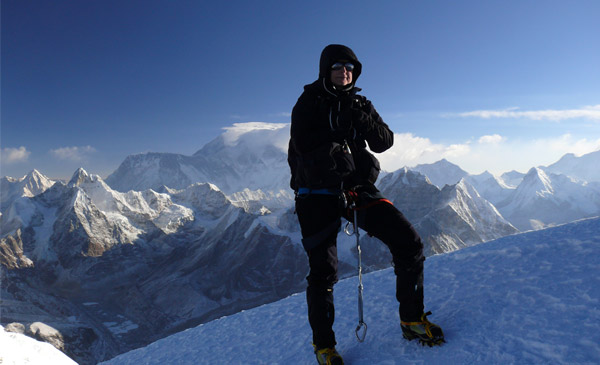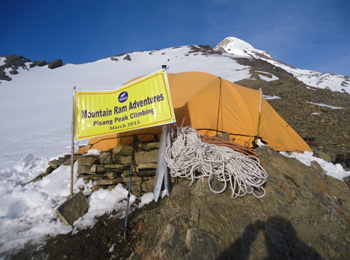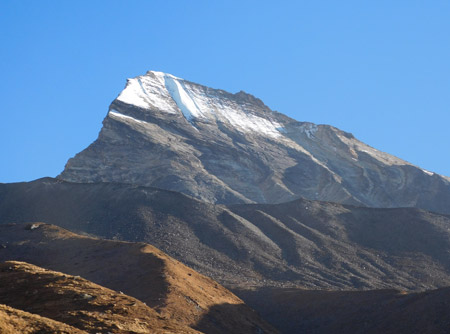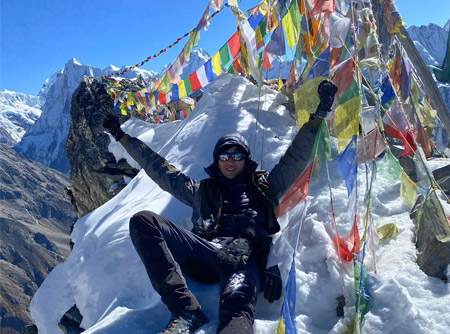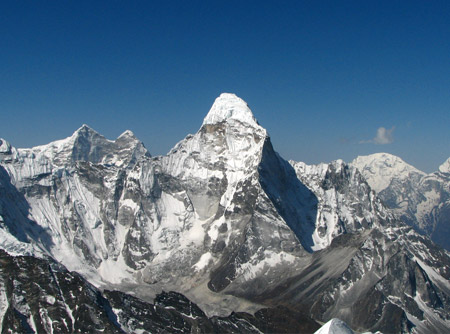- +977 9851074270
- info@mountainramadventures.com
Trip Highlights
- Sightseeing tour of the UNESCO World Heritage Sites within Kathmandu Valley.
- Enjoy the comfortable scenic drive in a 4WD through the midlands of Langtang region.
- Experience the authentic Tamang Culture of the Langtang Region.
- Summit the Naya Kanga Peak at an elevation of 5844 M.
- Witness the Glorious panoramic views of the Langtang Himalayan Range.
- Trek through the Lush Green forest with a high chance of encountering wild faunas of the Himalayan Region.
- Explore the Buddhist Monasteries along the trekking trail.
Detail About Naya Kanga Peak Climbing
Ganjala Chuli 5,844 m (Naya Kaga) is the one of the beast and adventurous climbing spot in Nepal which includes Langtang-Helambu trek in Nepal.Langtang region is a popular, famous and amazing destination for climbing snow peaks and spectacular panoramic views of mountains in Nepal. It has easy access to the region and availability of several snow peaks scattered around for acclimatization make this region an ideal destination for novice as well as experienced climbers. Naya Kanga is an attractive peak rising to the west of the Ganja La pass (5,844m/16).
Ascending to Ganja La and the summit of Naya Kanga offer the spectacular panoramic views of mountains in Nepal and Tibet including Langshisa Ri (6,370m/20,894ft), Pemthang Ri (6,836m/22,422ft), Shisapangma (8,046m/27,749ft), Langtang Lirung (7,425m/24,354ft), Pemthang Kapro Ri (6,830m/22,402ft) and Langtang II (6,571m/21,553ft). The normal route of ascent to Naya Kanga is via the north – East Ridge over a line on ice and snow. We follow the route of Langtang trek to Kyangjin (3,749m/12,297ft) for the ascent of Naya Kanga. To the north above Kangjin, there are several hills that provide both the magnificent views and acclimatization. Northeast of Kyangjin RI (4,700m/15,416ft), there are two peaks; Yala Peak (5,500m/18,040ft) and Tsergo Peak (5,749m/18,857ft) that provide good climbing for acclimatization. Climbing Naya Kanga from North-East Face and North Ridge.
Crossing the Langtang Khola below Kyangjin, we climb steeply along the ridge through a forest of rhododendron and juniper. Finally climbing more gently, we arrive at yak pastures of Ngegang at about 4000m. We continue following the trail to Ganja La climbing steeply through moraine . We leave Ganja La trail to climb steeply up yet more moraine to reach the eastern end of the glacier shelf beneath the north-east face of Naya Kanga. We set up the high camp here for the ascent. We cross the glacier shelf to the foot of a shallow couloir heading to the north ridge. We climb the couloir to the notch and the base of the ridge. Then we turn to the ice nose on the left which is only the technical section on the climb. Now the ridge widens and leads to a small col. on the east-west summit ridge and the summit is only 30m higher to the right. The climb near the summit should be done carefully. Normally, the ascent takes 5-7 hours from the high camp. For the return trek, we may follow Ganja La-Helambu route or back the way we came in to Dhunche.
Trip Itinerary Expand All
- 3 Star Hotel
As the Naya Kanga Peak climbing tour with the Mountain Ram Adventures is beginning the clients will be arriving at the Tribhuvan International Airport where they will meet the representatives of the team who will be transferring the clients to their designated hotel in Thamel area. The clients can freshen up and explore the Thamel area as it is filled with Pubs, Restaurants, Cafes etc. The clients can purchase the gears they are missing for the successful summit of the Naya Kanga Peak from the Local vendors of Thamel at very affordable rates.
- Breakfast
- 3 Star Hotel
the seven UNESCO World Heritage Sites within Kathmandu Valley. The clients will be accompanied by an English speaking Licensed Cultural guide for the entirety of the trip providing necessary details about the sites to the clients. After the completing of the Sightseeing tour at around 4-5 PM the clients will be dropped at their hotel after which they can freshen up and explore the Thamel area for a bit as the Mountain Ram Adventures Team will be organizing a small briefing at the head office where the plans and schedule will be discussed for the successful operation of the Naya Kanga Peak Climbing.
Highlights of the Sightseeing tour
Swayambhunath
Swayambhunath means “Self-Created” as it is believed that the stupa emerged from a lotus flower when the Kathmandu Valley was a big water body. The Swayambhunath Stupa has been serving as one of the most sacred sites for the Buddhist and Hindu community for around 1600 years and is situated at the Gopuchha Hill located at the Western part of Kathmandu and can be accessed only after climbing a flight of 365 stairs. The Stupa is built in an Ashoka Style dome shape and is surrounded by shrines and temples. The Swayambhunath Stupa offers stunning views of the Kathmandu valley and the Snow capped peaks of the Langtang, Jugal and Rolwaling Himalayan Range.
Pashupatinath Temple
Pashupatinath Temple is regarded to be one of the most sacred places for the devotees of hinduism. The temple is dedicated to Lord Shiva, the god of destruction. According to a chronicle within the vicinity of the Temple it is believed to be created by Pashu Prekshya of the Somadeva Dynasty at around 205 CE (more than 2200 years ago). The temple was brought to its current state after the renovation project carried out by King Bhupalendra Malla in 1697 AD. The temple observes thousands of devotees annually arriving to offer various offerings and blessings. The Temple is situated just beside the banks of the highly revered holy river Bagmati. The temple also serves as one of the biggest open cremation sites of the Hindu community and it is strongly believed that devotees cremated there find their passage to the next life.
Boudhanath Stupa
Boudhanath Stupa is located at the north east outskirts of Kathmandu around 6 KM from the center and serves as one of the major hubs for the followers of Buddhism all around the world. The Stupa is believed to be built during the Licchavi Period of Nepal which lasted from 450 CE to 750 CE. The Stupa is built in the Ashokan Dome shaped structure standing around 36 M tall and is the biggest Stupa of Nepal. The Bouddhanath Stupa is surrounded by Cafes, Restaurants providing stunning views of the Stupa offering the visitors peace and tranquility away from the hectic lifestyle of the city even though located within one of the prime locations of the valley.
Patan Durbar Square
Patan Durbar Square is one of the ancient complexes which consists of meticulously built architectural marvels including Palaces, Hitis, Courtyards, Temples, Shrines which reflect the ancient culture and history of the locals. The Patan Durbar Square used to serve as the headquarters of the whole of Kathmandu valley until the rule of Yaksha Malla (1429 AD-1482AD) after which the valley was divided into three separate kingdoms being: Kathmandu , Lalitpur and Bhaktapur. The Durbar Square consists of some of the country's finest architectural masterpieces which hold huge significance for the locals and the Hindu community. The iconic landmarks such as Krishna Temple, Bhimsen Temple, Hare Shankar Temple are located within the Patan Durbar Square Complex..
- 6-7 hours
- Breakfast, lunch and dinner
- Tea House
On our 3rd day of the trip we will be heading to the starting point of our trek, Syabrubesi. The drive to Syabrubesi will be around 7 hours long, taking us around 122 KM North from the capital city, Kathmandu. We will be traveling through the twisting and winding roads on a comfortable 4WD vehicle passing through beautiful landscapes filled with the natural views of the lush green hills and intimidating peaks tucked behind the hills. We will be heading towards Galchi via the Prithivi Highway and then taking a sharp right turn from where we will be heading towards Syabrubesi after which we will be passing through small settlements of the Lower Langtang region taking us eventually to Syabrubesi often regarded as the Gateway to the Langtang Region. We will be spending our nights at Syabrubesi for the night in local tea houses operated by the hospitable people of the local community.
- 5-6 Hours
- Breakfast, lunch and dinner
- Tea House
After having a goodnight rest at Syabrubesi we will be heading towards Lama Hotel which marks the beginning of our adventurous trek towards the summit of Naya Kanga Peak. The trek from Syabrubesi to Lama Hotel is around 12 KM long and will take us around 6 hours to complete. The trail will take us through the lush green forest of the lower Langtang Region alongside with the Langtang Khola. We will be passing through Bamboo, Rimche and Tatopani where we can rest for a bit if necessary. If we are lucky then we can also encounter the native species of the Langtang region as we will be trekking through the abundant forest. After a comfortable trek we will reach Lama hotel where we will be spending our night in a cozy tea house.
- 5-6 Hours
- Breakfast, lunch and dinner
- Tea House
We will be heading towards Langtang village after having a proper nutritious breakfast. The trek from Lama Hotel to Langtang Village is around 15 KM long and will take us around 6 hours to conquer. The trail to Langtang village is filled with rugged trails as the route was mostly damaged by the devastating earthquake of 2015 AD, as well as the whole of old Langtang village was also swept away by landslide brought by the earthquake of 2015 AD. We will be passing through the landslide zone of the old Langtang village and continuing our trek through the rugged yet adventurous trail we will eventually reach Langtang Village where we will be resting for the night.
- 4-5 Hours
- Breakfast, lunch and dinner
- Tea House
After enjoying the golden sunrise in the Himalayas we will be having our hearty breakfast after which we will be heading towards Kyanjin Gompa. The settlement of Kyanjin Gompa is situated at an elevation of around 3800M and is inhabited by the people of the local Tamang community. We will be gaining an altitude of around 490 M covering a total distance of around 7.1 KM. The trail to Kyanjin gompa is just beautiful as we will be greeted by the sight of majestic mountains of the Langtang Himalayan Range including the mighty Langtang Lirung 7234M. We will also be crossing a glacier stream flowing down from Langtang Lirung. After a beautiful 4-5 hours trek we will finally reach Kyanjin Gompa where we will be staying for the night.
On our 7th day of the trip we will be resting in Kyanjin Gompa soaking in the views and enjoying our time there. The day will be spent relaxing and indulging with the locals. The rest day also assists us for acclimatization as we will be gaining substantial altitude in our coming days of the adventure. We will be exploring the Kyanjin Gompa region and the valley enjoying the scenic yet intimidating views of the Himalayas. After having a proper well deserved rest for acclimatization we will be having our dinner and resting for the night in Kyanjin Gompa.
- 5-6 Hours
- Breakfast, lunch and dinner
- Tent
After enjoying the views of the peaks in the morning while having our hearty breakfast we will be heading towards the base camp of Naya Kanga Peak. We will head south from Kyanjin Gompa passing through the Langtang Khola after which we will be ascending towards the Base camp passing through lush Oak and Rhododendron forests. After the steep climb we will reach a pasture land of the Yaks which provides stunning views of the Himalayas. After arriving at the Naya Kanga Peak Base Camp we will be setting up our camp at a nice flat area. After setting up the camp we will be having meals prepared by our team members which will be hearty and warm. After having our dinner we will be sleeping in our tent resting good for the challenging climb to the High Camp the next day.
Note: we will be returning back to Kyanjin Gompa after the successful summit of Naya Kanga Peak so, the clients can leave their extra non essential items like dirty clothes in the tea house of Kyanjin Gompa which you can collect after returning back. The items will be safe in the teahouse and there is no need to worry about it.
- 5-6 Hours
- Breakfast, lunch and dinner
- Tent
After a goodnight rest we will have our breakfast and will be heading towards the Naya Kanga High Camp after packing up our campside. The trek today will be challenging as we will be passing through rugged terrains filled with boulders and uneven paths so we need to watch our steps to not twist our ankles. After trekking through the harsh terrain we will begin our trek alongside a glacier after which we will reach the high camp. The trek from Base Camp to High Camp is a short yet challenging one and after reaching High Camp we will unload and set up our camp after which we will be provided with a short training by the climbing guides teaching us some maneuvering and climbing skills and tips for a comfortable and safe summit. As the temperature drops during the night time we will be having an early night sleep after a nutritious dinner so that we will be well rested for the adventurous peak climbing the next day.
- 8-9 Hours
- Bed, Breakfast, lunch and dinner
- Tent
On our 11th day we will be waking up well before dawn and having a warm breakfast fueling us for the summit of the Naya Kanga Peak. During the day, strong wind makes it much more difficult to summit the peak so we will be heading towards the peak before sunrise. There are ropes along the trail to the summit making it a bit easier however the trail is demanding so we will be ascending slowly according to our pace watching our footing. After a steep incline uphill we will reach the summit from where we can enjoy the 360 degrees panoramic views of the Himalayan peaks and Glacier valleys. After enjoying the views and feeling a sense of accomplishment we will be heading back towards our campsite at the High Camp and will be spending our night at the campsite.
The Mountain Ram Adventure has included an extra day considering the weather condition or any other factor that can obstruct the climbing of Naya Kanga Peak. The team has meticulously prepared the itinerary considering all the factors so we will be able to summit in preferable condition. We will be staying in High Camp during our spare day and attempt the summit the next day. The team will be well equipped with the meal preps and tools required for one extra day at High Camp. During the spare day we will be provided some brief training by the guides about the tips and maneuvering skills and can also explore the High camp area acclimatizing for the challenging summit.
- 6-7 Hours
- Breakfast, lunch and dinner
- Tea House
On our 13th day we will be heading back towards Kyanjin Gompa passing through familiar trails of the Langtang Region. We will begin our trek after clearing our campsite, picking up any waste and having a heavy breakfast as we have a long trek ahead. We will be savoring the majestic views of the Langtang Himalayan Range and heading downhill towards Kyanjin Gompa cherishing every moment of the majestic trek. We will be spending our night in a cozy tea house run by the locals of the Tamang community at Kyanjin Gompa.
- 6-7 Hours
- Breakfast, lunch and dinner
- Tea House
After a well deserved rest in the cozy tea house we will begin our morning with a warm breakfast and glorious views of the Himalayas and the glacier valley. After packing for a bit we will begin our descent from Kyanjin Gompa towards Lama Hotel passing through the Langtang Village and nostalgic forest filled with the mesmerizing sound of the Langtang Khola. If we are lucky then we can also encounter some of the elusive species of the Langtang Region as well which is quite rare. After trekking for around 7 hours and covering a total distance of around 22 KM we will finally reach Lama Hotel where we will be spending our night just enjoying and interacting with other fellow trekkers.
- 5-6 Hours
- Breakfast, lunch and dinner
- Tea House
On our 15th day we will be heading back towards Syabrubesi. The trek will take us along the familiar routes beside the Langtang Khola passing through Bamboo. We will be trekking mostly through the familiar trekking paths alongside the Langtang Khola and will be crossing the Langtang Khola after which we will reach a junction which separates the trail of Gosainkunda Trek and Langtang Valley Trek. We will be heading towards Syabrubesi which we will reach after a short trek from the junction marking the end to our adventurous trek and climbing of the Naya Kanga Peak in Langtang Region
- 6-7 hours
- Breakfast
- Tea House
As the Naya Kanga Peak Climbing tour is successfully completed we will be heading back towards Kathmandu from Syabrubesi. We will be traveling in a comfortable 4 WD vehicle passing through beautiful winding roads which lead us towards Kathmandu. We will be covering a total distance of around 122 KM. After reaching Kathmandu the clients will be dropped at their designated hotel. After reaching the hotel the clients can freshen up and explore the vibrant city of Kathmandu and during the time they will be joining the Mountain Ram Adventures team on a farewell dinner (complimentary). The team will be celebrating the successful summit of the Naya Kanga Peak and marking the accomplishment by providing a certificate to the clients recognizing their achievement. After the dinner the clients can return back to their hotel for a well earned rest.
As the Naya Kanga Peak Climbing tour is officially completed the clients will be transferred to the Tribhuvan International Airport by the representatives of the team who will be assisting the clients with their Hotel Formalities and baggage and transferring them in a comfortable private vehicle. Whilst in the ride the clients can provide their honest feedback about their journey so that the team can even better their service. The team will be bidding the clients farewell at the airport and will be waiting for a call back from the clients to accommodate them for their next adventure to the Himalayas.
An elevated point of 5416m. You will be mountain climbing in the main on well established trails. Come and join a Great adventure trip.
Cost Includes
- Pick up and drop from and to International Airport.
- 3 nights’ accommodation in Kathmandu on B/B plan.
- All accommodations during the treks on tea house and tent.
- Transport by car.
- Langtang National Park permit.
- TIMS (Trekkers’ Information Management System).
- Peak Permit (Climbing permit).
- Breakfast, lunch and dinner during the trekking and climbing period.
- Tea, coffee, hot water during the trekking and climbing.
- Map of the area.
- Climbing guide / Trekking guide / necessary porters. (all insured, salary, food, accommodation, equipment’s and so on )
- Camping equipment like tent, mattress and cooking stuff while climbing period.
- Climbing equipment like climbing rope, Ice crew, snow bar, ice axe.
- First aid kit.
- Government Tax and Company service charges.
Cost Excludes
- Bar and beverage bills,bottled water, desserts, hot shower
- Climbing equipments (Boots, Crampons , Harness belt, caravina, Gaiters, Joomer and so on).
- Personal expenses, personal clothes,personal insurance for health and evacuation
- Tipping
Frequently Asked Questions Expand All
Naya Kanga Peak Climbing is considered to be a strenuous climb and requires a lot of technical skills for successful summit of the peak. The Naya Kanga peak climbing falls under the PD+ (Peu Difficile) Alpine Grade and demands quite a lot of the climbers as the trail to the summit is filled with snow slopes requiring proper footing and can be done only using crampons/ Microspikes. The Peak can be conquered by the assistance of well experienced climbing guides who are well aware about the terrains and challenges.
To conquer the Naya Kanga Peak you don't require any past climbing experience but the clients should be physically fit to endure the challenges as the climbing falls in the strenuous category. The climb can be easily done by climbers with the help of expert climbing guides. The climbers are suggested to establish a exercise routine 2-3 months before participating in the Naya Kanga Peak climbing to make sure the clients will be well prepared for the trek and also do a whole body checkup to ensure during the peak climbing any physical complication won’t arise.
Yes, the Naya Kanga Peak can be summited during the Winter and Monsoon season however, the climb will be much more complicated as the weather conditions of the Upper Langtang region can be unbearable at times so the climbers should be well prepared to tackle the obstacles. The climb can be conquered if the climbers are well equipped and have the back of an experienced climbing team.
As we will be trekking through the Langtang National Park the possibility of encountering the elusive native species of the region is quite high. The National park is home to some of the endangered species of faunas including Red Panda, Snow Leopard, Yellow Rumped HoneyGuide, Tragopan, Impeyan Pheasant and many more. The trekkers can encounter majestic beasts during the trek if they are lucky. If the trekkers are keen for bird watching then carrying binoculars can be beneficial as the Langtang Region is home to more than 370 species of birds.
Yes, During the Naya Kanga Peak Climbing there is a high chance of getting sick due to the altitude level. We will be climbing to an altitude of 5844 M. Due to the low oxygen level and atmospheric pressure the clients can feel lightheadedness which is considered to be normal but make sure to inform the team members so they can monitor the situation. The team assigned will be well equipped with first aid supplies and have basic medical training and can mitigate the situation as best as they can and will request for emergency evacuation if situation worsens during which the clients will be transferred via Helicopter to a well equipped medical facility in Kathmandu.
Yes, the climbers are required to have a special climbing permit issued by the Nepal Mountaineering Association (NMA). The special permit fee varies from time to time depending on the season. For the international tourist/ climbers The permit cost per climber is 250 USD in spring season, 125 USD in Autumn season and 70 USD in Winter/ Summer season. The trekkers will require additional 3 permits as well, including the TIMS Card, Langtang National Park permit and Garbage Disposal Fee. The travelers traveling with the Mountain Ram Adventures permit will be applied and collected by the team and the permit fee is inclusive in the package and will not cost any additional charge.
Note:The Garbage Disposal fee is covered by the team and not by the clients as the amount will be returned back by the concerned authority if all the waste is brought back from the Naya Kanga and properly disposed of.
Useful Information
- Itinerary disclaimer
The Naya Kanga Peak Climbing tour presented by Mountain Ram Adventures operates strictly as per the itinerary provided to the clients and all the necessary arrangements and bookings for the operation of the trip are made well before the beginning of the trip. The team requests for cooperation and understanding from the clients during any arisal of any unforeseen events such as landslide, political events, ill mannered groups which can change the course of the itinerary. The team members will decide upon the next course of action with the clients best interest at heart and the current condition and will be relaying the information to the clients as soon as possible. - Airport Pickup and Drop
During the entirety of the Naya Kanga Peak Climbing the Mountain Ram Adventures will be arranging for all the necessary commutes required for the smooth and successful operation of the trip. The Airport Pickup and Drop facility provided by the Mountain Ram Adventures team is a complimentary service during which the clients will be transferred from the Tribhuvan International Airport (TIA) to/from their hotel in Thamel area. The clients request for route change will incur in some additional charges which will not be covered by the Mountain Ram Adventures Team. The transportation arranged by the team includes transfer from/to TIA, 4WD drive from/to Syabrubesi and Sightseeing vehicle. - Naya Kanga Peak Evacuation and Insurance
To participate in the Naya Kanga Peak Climbing tour with the Mountain Ram Adventures the clients must be compulsorily insured as even though considered to be one of the easiest peak climbing in Nepal the Naya Kanga Peak Climbing is full of strenuous challenges and as the trekkers will be reaching an altitude of 5844 M the risk of altitude sickness is quite high. During any medical emergencies the climbers are suggested to inform their guides about it who will then assess the situation providing the clients with first aid medical treatment and will be checking the oxygen level using an oximeter. The clients safety and security is the first priority of the team and if the health of the clients get even complicated then the team will contact the Head office who will then request for emergency evacuation after which the clients will be transferred to Kathmandu via a helicopter. The climbers need to have an insurance to participate in the Naya Kanga Peak climbing so that during any emergency evacuation and medical costs will be covered partially or fully by the insurance. - Naya Kanga Peak Climbing with Climbing guides
The Mountain Ram Adventures Team will be assigning the guides and porters for the tem who will be responsible for the climbers safety and smooth operation of the trip. The team assigned will have a lot of past experience and knowledge about the region and will be sharing them with the climbers ensuring they have a comfortable and enjoyable journey to the summit and back. The Mountain Ram Adventures will assign Climbing guides for the Naya Kanga Peak climbing which will make the journey much more comfortable. The Mountain Ram Adventures will also be assigning the climbers guides who will be carrying the extra baggage of the climbers and the camping gears of the team. We request the climbers to treat the guides and porters assigned for the trip with respect and love as they are the part of the Mountain Ram Adventures family and without the contribution of guides and porters trekking and expeditions in the Himalayas will be near impossible. - Difficulty and Past Climbing experience for Naya Kanga Peak
For the Naya Kanga Peak climbing the trekkers don't need any past climbing experience but it requires some technical maneuver skills and a lot of physical and mental preparation. Even Though considered to be one of the simple and easy peaks to conquer in Nepal the climbers should be well prepared to tackle the hurdles which will arise during the climb. The climbers will be accompanied by experienced team members assigned by the Mountain Ram Adventures and will assist the climbers with everything they can offer and make the journey as smooth as possible. The climbers are strongly advised to have a medical checkup before participating in the Naya Kanga Peak climbing to ensure they are ready to endure the harsh conditions of the Himalayas. The climbers are suggested to do regular exercise and stretching for a couple of months before the beginning of the peak climbing so they are prepared to endure the challenges. - Why choose Mountain Ram Adventures for the Naya Kanga Climbing
Mountain Ram Adventures has been serving as one of the most reputed companies for trekking and expedition for more than a decade. The members assigned by the team are well skilled and can assist the clients to pass any hurdles during their trip so, the clients will be in good hands for the entirety of the trip and can focus on climbing and enjoying the views offered during the peak climbing.
Well Qualified Guides and Porters
The Guides assigned by the Mountain Ram Adventures are licensed and are well qualified to assist the clients during their expedition of the Naya Kanga Peak. The Guides assigned will be able to communicate with the clients in English and will be sharing their vast knowledge about the surrounding, peaks and relative information. The porters assigned for the trip will be carrying the load of the clients and the camping gears for the team. One porter will be assigned for two trekkers who will be carrying a total of 20 KG (10 KG each). The team will be accompanying the clients for the entirety of the trek and will be assisting incase of any emergencies as well.
Pre planned services
The Mountain Ram Adventures team will be making all the necessary arrangements for the success of the Naya Kanga Peak climbing and will be pre booking all the necessary facilities and services required for the trip before the trip commences. The required accommodations, meals, documents, commutes will be taken care of by the team so the clients will have a smooth trip with no additional stress regarding the trip.
Customizable and flexible Packages
The packages offered by the Mountain Ram Adventure team are flexible and can be customized according to the travel preference of the clients. The team offers various packages to the traveler who can choose according to their demand and preferences. The itinerary for the Naya Kanga Peak climbing is also flexible, offering time for acclimatization and spare days for bad weather conditions (if required).
Sustainable tours
The trips organized by the Mountain Ram Adventures are well operated with the goal of preserving the destination in mind. It is the responsibility of the team as well as the clients traveling to any destination to leave behind as little as possible. The team also follows moral codes of tourism by fairly treating the locals, proper disposal of waste and environment conservation. - Alternative Peak Climbing
Mountain Ram Adventures offer various expedition packages beside the Yala Peak climbing in various regions of Nepal ranging from smaller non technical peaks including Mera Peak (6476M), Chulu East Peak(6584M), Lobuche East Peak(6119M) all the way to the highest peak expedition of the world Everest Expedition taking us to the summit of Mount Everest at 8848.68 M. The clients will be assigned team representatives (guides and porters) accordingly for the trip accessing the complexity of the expedition.
The Mountain Ram Adventures also offers various trekking packages taking the clients to well renowned trekking destinations as well as remote trekking destinations with less crowd. The clients can select the packages which meet their travel preference and time at Trekking Packages offered by the Mountain Ram Adventures. The packages offered by the team are customizable and flexible and can be changed by the clients fitting their schedule and needs. - Clients Feedback
The valuable feedback provided by the clients are crucial for the growth of the team's service and facility. We take the criticism and feedback seriously and request the clients to provide honest feedback to better our services. The team will be hosting a farewell dinner on the last night of the trip during which the clients can provide the necessary feedback to the team members and they can also leave their review at the official website or google directly. - Total cost for the Naya Kanga Peak Climbing
The Naya Kanga Peak Climbing tour package offered by the Mountain Ram Adventures includes all the facilities and services required for the successful summit to the peak of Naya Kanga Peak. The clients can check the cost include and exclude section above to find out what amenities are included and excluded. The price per person for the Naya Kanga Peak goes as low as 1800 USD for a group of 7 or more clients and goes up to 2000 USD for a group of 2-6 clients and for solo trekkers it goes up to 2250 USD. The rates offered by the team is calculated and includes various complimentary services within the rate as well making it a value of r money package. The clients will have less to no stress of any travel plan and the trip will start and end according to the trip's itinerary provided to the clients. - Accommodations and meal during the trek
During the Naya Kanga Peak Climbing the Mountain Ram Adventures team will assign the clients with rooms on a twin sharing basis. The clients will be staying in a three star accommodation while in Kathmandu. Along the trekking trail till Kyanjin Gompa the clients will be staying in cozy tea houses and after that the clients will be staying in Tents which are carried by the porters assigned for the trip by the Mountain Ram Adventures as there are no accommodations above the Kyanjin Gompa. The client's will be also staying in the tent on a twin sharing basis. During the trip all the necessary arrangements are predetermined and booked before the trip begins so the clients can have hassle free travel.
During the trip the Mountain Ram Adventures team will be responsible for managing three meals per day during the trek including breakfast, lunch and dinner. The clients will be staying in B&B Basis (Bed and Breakfast) during their stay in Kathmandu. The meals provided by the team are listed in the cost include and exclude section above. During the trek the clients can enjoy meals which are highly nutritious and hearty and can fuel them up for the trek. The trekkers are suggested to enjoy their meals and consume a balanced and healthy meal. The trekkers can enjoy meals made by the locals using mostly locally produced ingredients. During the trek we will also be staying in tents (in Naya Kanga Base Camp and High camp) and will be consuming the meals prepared by the team members who will be carrying meal preps and ingredients for the camp, the meals prepared by the team will be nutritious to fuel the clients up to conquer the peak of Naya Kanga. - Best Time to Summit the Naya Kanga Peak
The peak of the Naya Kanga Peak can be conquered all around the year but during the “off season” it is much more challenging and difficult to summit the peak. The off season months cover the months of December to February (Winter Season) and June to August (Monsoon/ Summer season). Even though it is possible to summit the Naya Kanga Peak the risk and difficulty is too high during that time so we suggest the climbers plan their trip during the Spring or Autumn Season which is usually the best time to summit the Naya Kanga Peak. The months of September to November (Autumn Season) and March to May (Spring Season) are considered ideal for peak climbing or overall any adventure activities in the High Himalayas.
During the Spring Season and Autumn season the weather is pleasant and does not change much as it stays stable with gradual declines in temperature during night time. The weather is considered to be perfect for trekking in the High Himalayas as the skies are clear offering undisturbed views of the Himalayas. The routes of the Naya Kanga Peak climbing is shared with many of the Upper Langtang valley trek including Yala Peak Climbing and Langtang Valley Trek which separates after reaching Kyanjin Gompa so the trekking routes will be crowded during this time as trekkers from all around the world will be traveling to experience the best view the Himalayas have to offer. During the Spring season the wildflowers bloom making the trail even more appealing to the trekkers as the wild flowers produce aromatic fragrant making the trail even more magical and during this time the chances of encountering the wildlife is also quite high especially during the morning time.
The off season time is risky for peak climbing but is possible. The weather condition changes frequently without any signs which slightly causes problems. During the monsoon season the offbeat trekking trail is slippery and muddy making it difficult and dangerous to navigate through. The rainy monsoon clouds disrupt the view as the Himalayan peaks are well hidden. The risk of landslides and Thunderstorms is also at its high during this time. The trekking routes of the Naya Kanga Peak also takes us through the abundant forest of the Lower Langtang Region which will be filled with bugs including leeches and mosquitoes making it difficult to trek. If the trekkers are planning to trek during this time they require water proof gear and raincoat compulsorily for the success of their trip. During the winter season the temperature at the higher elevation remains constantly below freezing turning the upper valley into a frozen paradise. If the trekkers are planning to trek during the winter time they need warm heavy clothes and gears including crampons, poles etc. The risk of avalanches and extreme weather (snow storms) can also become a huge problem. Overall during the off season the peak climbing is possible however the assistance of highly skilled guides and porters is required so, if you are planning to climb the Naya Kanga Peak with the Mountain Ram Adventures then you will be in safe hands as experienced guides and porters are assigned to the clients for the trip by the team. - Permits for Naya Kanga Peak Climbing
The climbers must obtain a certain number of permits to participate in the Naya Kanga Peak Climbing. The free individual trekkers can collect all of the required permits within Kathmandu valley and will need documents to apply for them. The required documents are listed in the Department of Immigration Nepal website.
Peak Climbing Permit:To summit the Naya Kanga Peak the clients must pay a royalty fee for the expedition. The climbers need to visit the Nepal Mountaineering Association (NMA) office situated at Manakamana Marga, Kathmandu.
For Nepali Citizens(NPR)
Spring season: 4000 NPR, Autumn Season: 2000 NPR, Winter/ Summer: 1000 NPR
For Foreign Citizens(USD)
Spring: 250 USD, Autumn: 125 USD, Winter/ Summer: 70 USD
Langtang National Park Permit
Cost of the Permit- Langtang National Park permit cost for other nationals: Rs 3000
- Langtang National Park permit cost for SAARC nationals: Rs 1500
- Langtang National Park permit cost for Nepali citizen Rs 100
TIMS Card
- TIMS Card is not required for Nepali citizens
- TIMS Card cost: NPR 2,000 per trekker.
- Garbage Disposal Fee
The Garbage Disposal fee is charged by the NMA while collecting the climbing permits. However the full amount is refunded to the climbers upon their tour completion and if they are able to bring back all the garbage and is properly disposed of safely. The total fee charged by the NMA for the Garbage Disposal is 500 USD per climber and is included in the package.
Note: The Mountain Ram Adventures team will be covering the cost of the garbage disposal fee so the refund amount of the fee is kept by the team and not provided to the clients.
The Mountain Ram Adventures will be applying for the clients permit and will also be collecting on behalf of the clients so they can have a stress free journey. All the permit fees are included in the package and does not require any additional charge later on during the trip. - Basic Information for the Naya Kanga Peak Climbing
Internet: The climbers can enjoy the facility of internet till Kyajin Gompa which will not be so stable and will be slow. The tea house charges a certain fee per person to use the internet which is not included in the package and is a personal expense of the climbers. The climbers can use Mobile data by first obtaining a Nepali Sim Card from either NCell or NTC and purchasing the data pack according to the client's desire. The data packs are rather cheap and can also be used multiple times throughout the trip.
Hot Shower: Trekkers are suggested to have a hot shower if it is absolutely necessary only as if the body is not properly dried then health complications such as cold, pneumonia etc can arise making it difficult for the climbers. The hot showers will be available up to Kyanjin Gompa and will cost a certain sum paid by the clients themself to the tea house.
Charging: the facility of charging will be slow and limited in the Langtang region so the trekkers are suggested to carry a fully charged power bank for the Naya Kanga Peak Climbing to ensure their electronic devices are fly charged for the trip. The facility of charging will be there up to Kyanjin Gompa and some tea houses tend to charge a certain fee for charging the electronic (per device). The trekkers fee for charging is not covered by the Mountain Ram Adventures team.
ATMs and Money Exchange: the clients are requested to withdraw the required estimated amount for personal expenses and emergency fund for the trip while at Kathmandu. The trekkers will be charged a certain fee per transaction ranging from 3-6% depending on the bank as international transaction fee. If the trekkers have cash then they can exchange their countries currency into NPR as well from the local money exchange vendors. Make sure to be updated in the exchange rate inorder to get the best rate and not get scammed.
Snacks: The trekkers can purchase some snacks like protein bars, chocolates, sweets, gums for their adventure. We will be trekking for around 6 hours on average per day so the trekkers will need a lot of energy so buying some snacks for the trail can become beneficial and provide a little burst of energy for the trek. - Risks During Naya Kanga Peak Climbing
Altitude Sickness
During the Naya Kanga Peak Climbing the risk of altitude sickness is quite high as we will be trekking to an altitude of 5844 M at which the oxygen level is around 40% from the sea level causing problems in respiration and during which the clients feeling lightheadedness is considered to be normal. The oxygen level and atmospheric pressure can cause a lot of medical problems related to altitude sickness so if the clients feel any discomfort or symptoms of Altitude Sickness like headache, nausea, dizziness, loss of body coordination, fatigue etc then they should inform their team members as soon as possible. The team members will be monitoring the situation and will be requesting for emergency evacuation if the situation becomes complicated.
Ways to prevent Altitude Sickness- Consume proper nutritious balanced meals.
- Drink around 3-4 liters per day at least during the trek.
- Do Not consume any products that can cause dehydration like Alcohol, Cigarettes, Caffeine.
- While on adventure listen to our body and walk according to your own pace.
Indigestion
During the Naya Kanga Peak Climbing the trekkers will consume meals prepared by the locals of the Tamang community using locally grown ingredients which are high in nutrition and fuels them for their journey ahead. The clients are required to inform the team if they have any medical condition, allergies, vegetarian etc so that the team can arrange accordingly during the trip. The clients can suffer from indigestion if they don’t consume nutritious balanced meals which can be a huge problem during the trip. The clients are strongly advised not to drink water directly from the water source as it can cause indigestion and upset stomach. In the higher region the clients are suggested to consume no meat as usually the meals prepared using meat are frozen which can also cause indigestion. - Contact Details of the team
The Team members of the Mountain Ram Adventures will be connected with the clients well before the beginning of the trek as they can contact us at +977 9851074270 directly or through Whatsapp and Viber. The clients can also contact the team’s head office which will be in operation during the working hours from 10 AM-6 PM NPT on +977 014701168. The clients can mail the team at info@mountainramadventures.com as well where the team will get back to the clients as soon as possible. - Visa Applications
Inorder to participate in the Naya Kanga Peak climbing the clients should firstly have a valid visa of Nepal which they can obtain easily by contacting with the Embassy of Nepal or the Consultant Office of Nepal in their own respective countries. The citizens of certain countries are also provided with the facility of visa on arrival at the entry points of Nepal including the Tribhuvan International Airport in Kathmandu. The clients can check whether they are eligible for the visa on arrival at the official website of the Department of Immigration of Nepal.
Note: Any visa related process is not the responsibility of the Mountain Ram Adventures as we cannot change the outcome and during any such unfortunate events the refunds will be done according to the policy of the Terms and Conditions of the Mountain Ram Adventures team.- Travelers Courtesy towards Nepalese Culture
- At the start of the conversation begin with “Namaste” which is a common form of greeting in Nepal .
- While going around any religious site, always go in a clockwise direction as it is considered to be the correct way. If you get confused then you can look at the direction which the general people are going through.
- Always take off your shoes while visiting someone's house or inside any religious sites as it is considered to be a common courtesy while entering.
- Never point at someone or something using your feet as it is considered to be extremely rude.
- Use the word”Dai” and “Didi” while addressing locals which means brother and sister respectively.
- Search for boards or signs to see whether tourists are allowed within the vicinity or not as there are quite a few religious sites where tourists are not allowed to enter.
- While traveling to any sites make sure to dress modestly and never show any form of affection as it is considered to be a private matter.
- Essential equipments for the Naya Kanga Peak Climbing
The Mountain Ram Adventures team will be providing the clients with a trekking checklist including all the equipment and gears required for the successful summit of the Naya Kanga Peak. The trekkers can purchase the required gears and equipment from the local vendors around the Thamel area as they are of good quality at a very affordable rate.
Essential: 4-5 Trekking Shirts, 4-5 inner garments, trekking trousers, fleece/ down jacket, inner wear, wind/waterproof jacket, trekking bags, Sun cap, Poncho, flask, sleeping bags, trekking poles, scarf, neck warmer, gloves, Microspikes.
Note: The Mountain Ram Adventures team will provide sleeping bags to the trekkers which will be rented and will be clean but will have been used by trekkers before them so, if they don’t want to use it then they can also bring their own personal sleeping bags for the tour.
Personal Kit: Wet wipes, Sanitizer, personal toiletries, sunblock cream, moisturizer, prescribed medicines (if any), toothbrush and toothpaste, insect repellent, antifungal cream.
Electronic gadgets: Phone, charger, powerbank, Camera, spare batteries, headlamps, torches.
Documents: Valid Visa, Passport, Travel Insurance, Permits, Photo, Identity card.



